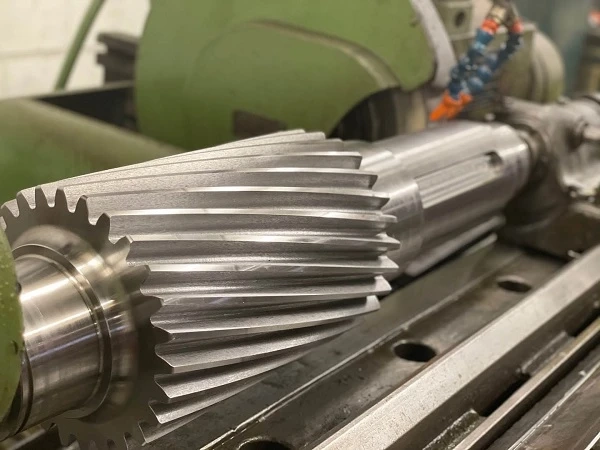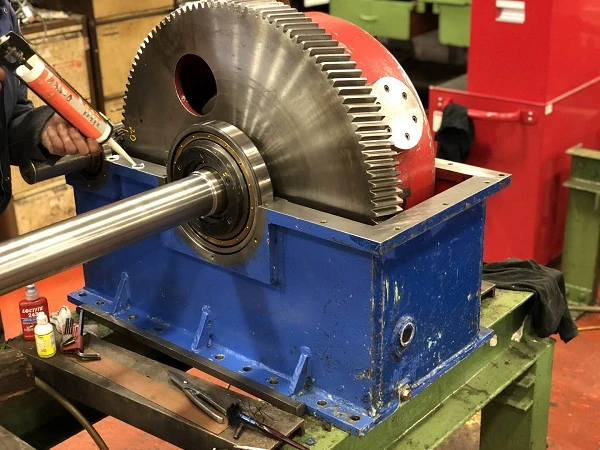Introduction to Material Selection in Gear Manufacturing
Why material choice matters from the outset?
The performance, reliability, and lifespan of a gearbox often trace back to a critical early decision: selecting the right material. Every gear must endure specific loads, rotational speeds, and environmental factors. Without the correct material, even the most precisely cut gear can underperform, wear prematurely, or fail entirely. Material selection isn’t just about strength — it defines how a gear responds under pressure, how it wears, and how it behaves during manufacturing.
Material choice also dictates the efficiency of the cutting process itself. Some metals lend themselves more easily to fine machining, while others require specialised equipment or extended lead times. This is where a knowledgeable Gear Cutting Company can provide guidance, helping engineers strike a balance between technical requirements and production realities.
Historical shifts in gear materials and manufacturing methods
In earlier decades, gear production focused heavily on tried-and-tested carbon steels, often shaped by labour-intensive manual methods. Over time, the introduction of alloys, heat-treated steels, and stainless variants expanded design possibilities. Manufacturers began using materials not only for their strength but for their compatibility with modern machining and heat treatment processes.
Today, automated CNC machining and stricter performance standards have pushed material selection to the forefront. The emphasis has shifted from “what’s available” to “what works best,” with engineers increasingly tailoring material choice to specific industry sectors and operational environments. As gear production becomes more advanced, material decisions carry even greater weight.
Understanding Gear Types and Material Demands
Spur, bevel, worm, and helical gear variations
Each gear type places different demands on the material selected. Spur gears, with their straightforward tooth alignment, generally tolerate a broader range of materials, making them suitable for cost-effective manufacturing. Bevel and worm gears, by contrast, often require materials with specific wear or thermal characteristics, especially when used in compact or high-load environments.
Helical gears, which feature angled teeth to reduce noise and increase torque transfer, typically need tougher materials. The angled contact results in more surface engagement and sustained load, so their material must balance hardness with shock resistance. These differences underline why a one-size-fits-all approach rarely succeeds in precision engineering.
How gear type influences material requirements?
Material selection must align not only with how the gear will be used, but with how it will be cut. Complex profiles or tighter tolerances require metals that respond predictably to machining, especially under the heat and pressure of high-speed CNC operations. For worm gears, thermal expansion properties are particularly important, while for bevel gears, edge integrity is key.
Failure to account for these differences can result in excessive wear, operational inefficiency, or even system failure. A skilled gear cutting company will assess the entire application, matching gear design with appropriate metal properties, cutting processes, and finishing treatments. This integration ensures longevity and peak performance across a range of industries.
Key Material Properties That Affect Gear Performance
Strength and durability under load
Strength isn’t a one-dimensional requirement in gear production. It refers to a gear’s ability to withstand continuous torque and sudden loads without deforming. Materials like hardened alloy steel offer high tensile strength, making them well-suited to heavy-duty applications such as mining, steel production, and marine propulsion. This resilience is especially important in helical and bevel gears, where contact stresses are distributed across larger surface areas.
Durability also involves resistance to surface fatigue. Repeated stress cycles can cause microcracks that eventually compromise the gear. Materials that offer high fatigue limits ensure longer operational life, reducing maintenance costs and downtime. For high-performance applications, additional treatments like carburising or nitriding can further enhance these properties, creating a hardened surface while preserving the core's ductility.
Wear resistance and lifespan
Wear resistance plays a direct role in extending a gearbox’s service interval. In environments where gears operate with minimal lubrication or under abrasive conditions, material selection becomes even more critical. Tool steels, with their high carbon content and uniform hardness, perform well in such settings. For quieter or enclosed systems, bronze or polymer blends may also be used to reduce friction.
A longer lifespan often results from combining strong materials with precise cutting. If the metal resists abrasion but is difficult to machine, the gear profile may suffer. That’s why Helical Gear Manufacturers often seek materials that strike the right balance — tough enough to last, but responsive enough to allow for fine, accurate cuts that don’t require excessive post-processing.
Heat treatment compatibility
Heat treatment significantly improves gear strength and wear resistance, but not all materials respond equally. Case hardening, induction hardening, and through-hardening are only effective on metals with specific compositions. For instance, low carbon steels may need enrichment before treatment, while alloy steels can be hardened directly to high Rockwell values.
Selecting a material without understanding its behaviour during heat treatment can lead to distortion or structural weakness. A reliable gear cutting company will not only choose a compatible base metal but also recommend the appropriate treatment cycle. This ensures each gear achieves the intended hardness and resilience without compromising dimensional accuracy.
Machinability and cost-efficiency
Machinability affects everything from tool wear to production speed. Softer metals like brass or aluminium machine quickly but may not offer the strength required for industrial gear use. On the other hand, hardened tool steels offer longevity but demand more advanced tooling and longer machining times, raising overall costs.
Balancing machinability with performance is a constant consideration. High-volume orders, especially those with tight lead times, benefit from materials that machine cleanly and consistently. This is where in-house CNC capability becomes crucial — allowing material choice to be optimised not just for performance in use, but also for efficiency during manufacture.
Common Materials Used in Gear Cutting
Carbon steels and alloy steels
Carbon steels remain a standard choice for many gear types due to their affordability and decent mechanical properties. They offer good machinability and can be enhanced with surface treatments like carburising to improve wear resistance. These steels are often used for spur and bevel gears in medium-duty applications where cost and efficiency must be balanced.
Alloy steels, which incorporate elements like chromium, molybdenum, and nickel, offer enhanced strength, hardness, and toughness. Their superior fatigue resistance makes them ideal for high-load and high-speed gear systems, such as those in automotive or heavy industrial settings. These steels also respond well to heat treatment, which allows for greater customisation of hardness and depth, critical in high-performance environments.
Stainless steel and tool steels
In environments where corrosion resistance is essential — such as food processing, pharmaceuticals, or marine applications — stainless steel becomes the preferred option. Grades like 316 and 17-4PH offer a combination of corrosion resistance and tensile strength, though they can be more difficult to machine and costlier than standard carbon steels.
Tool steels are chosen for their extreme hardness and stability during cutting. While these materials are typically more expensive and harder to machine, they perform well in abrasive or high-temperature conditions. Their use is often limited to specialist gear types or components that experience continuous impact or exposure to contaminants that degrade lesser materials.
Bronze, brass, and polymers in specialised use cases
Bronze and brass offer excellent wear resistance and low friction, which makes them ideal for worm gears and applications where noise must be minimised. Their self-lubricating properties help in reducing maintenance, although they lack the tensile strength of steels and are often reserved for lower-load systems.
Polymers, including advanced plastics like acetal or nylon, are increasingly used in gears that demand lightweight construction or electrical insulation. While their use in heavy-duty industrial settings is limited, they prove valuable in consumer goods, automation systems, or sectors where vibration damping is essential. Their quiet operation and corrosion resistance offer advantages in niche applications.
Case Study: Helical Gear Manufacturers and Precision Requirements
How material choice supports load and noise control?
Helical gears are designed for smooth, quiet operation under sustained load. The angled tooth design distributes force more evenly across the gear surface, which reduces noise but increases axial thrust. This places greater demands on material strength and surface finish, especially in high-speed applications. Helical gear manufacturers typically choose alloy steels that combine hardness with tensile strength to absorb this stress without deformation.
The precise tooth geometry of helical gears means the material must machine cleanly and consistently. Any inconsistency in the base metal can lead to profile inaccuracies or poor meshing, which in turn increases noise and wear. A material with stable grain structure and excellent dimensional integrity during heat treatment allows manufacturers to meet the tight tolerances these gears require.
Real-world material challenges for high-volume helical production
In high-volume environments, every efficiency gain matters. Materials that cause premature tool wear or require secondary processing can slow down production and increase costs. Helical gear manufacturers often face a trade-off: a harder material improves gear life but may require slower cutting speeds or more frequent tool changes.
Choosing the right material reduces this friction — both literally and operationally. It enables smoother machining, lower reject rates, and consistent quality across large batches. Working with an experienced gear cutting company also ensures access to a broader range of pre-tested materials and deeper expertise in how those materials behave during mass production.
The Role of a Gear Cutting Company in Material Advisory
Collaboration with clients during specification
Choosing a material isn’t a decision made in isolation. A skilled Gear Cutting Company works closely with engineers and procurement teams to understand the specific performance requirements of a gear. This includes the operating environment, load conditions, lubrication systems, and manufacturing constraints. By collaborating early in the design stage, the company can help prevent mismatches between material properties and gear function.
This collaborative process also ensures that gear materials align with project timelines and available stock. With supply chains facing increasing pressure, real-time consultation helps avoid delays caused by difficult-to-source metals. A responsive partner will recommend viable alternatives, balancing performance with availability and helping projects stay on schedule without sacrificing quality.
Material sourcing and traceability
Material quality begins at the source. A reputable gear cutting company ensures full traceability for all metals used, from mill certification to final inspection. This traceability is essential in industries where compliance and audit trails are required, such as aerospace, defence, and food processing.
Using vetted suppliers, these companies avoid unknown alloys or recycled blends that could jeopardise structural integrity. It’s not just about buying metal — it’s about securing reliable inputs that meet defined standards. With traceability in place, clients gain confidence not only in the gears themselves, but in every component behind them.
Balancing lead time, performance, and cost
Gear production doesn’t happen in a vacuum. Tight deadlines, cost targets, and long-term maintenance plans all influence material choice. An experienced gear cutting company weighs these factors to deliver the right product for the job — one that performs reliably without inflating the budget or extending delivery windows.
Striking this balance is especially important for legacy systems or urgent repairs. In those situations, speed often matters as much as durability. The ability to recommend and machine a substitute material quickly is a key differentiator, particularly when avoiding the cost and delay of importing original parts.
CNC Machining and Its Influence on Material Viability
Tolerances and repeatability across metal grades
CNC machining plays a pivotal role in how different metals perform during gear production. High-precision CNC systems can hold tolerances to within microns, but this capability is only useful if the material responds predictably to the cutting process. Some metals expand or harden during machining, which can throw off measurements if not correctly managed.
Consistency across production runs also depends on the metal grade. Variations in hardness or composition can lead to slight shifts in how the material behaves during cutting. Advanced CNC setups, combined with rigorous quality checks, ensure that gears produced from different batches maintain uniformity — a critical factor for clients who demand repeatable performance.
Challenges with harder or exotic materials
Harder metals, like certain tool steels or hardened alloys, often present machining challenges. They require slower cutting speeds, enhanced coolant systems, and frequent tool changes to avoid edge chipping and surface burn. While these challenges are manageable, they impact lead time and cost.
For exotic materials — including titanium or nickel alloys — the complexity increases. These materials can offer unique benefits such as corrosion resistance or high-temperature stability, but they demand advanced tooling and programming strategies. Only companies with in-house expertise and robust equipment can reliably produce gears from such materials without sacrificing accuracy or delivery time.
Benefits of in-house CNC machining capabilities
Having in-house CNC machining transforms how material choices affect production. It reduces delays associated with outsourcing and allows real-time adjustments to cutting parameters based on material feedback. Engineers can trial different approaches, optimise speeds and feeds, and immediately check for accuracy without relying on external suppliers.
This control not only enhances quality but gives clients more flexibility. If a gear design changes or a different material is needed at short notice, the team can respond quickly. For applications where uptime is critical, this level of responsiveness can be the difference between extended downtime and rapid recovery.
Sector-Specific Considerations for Material Selection
Food-grade requirements and corrosion resistance
Gears used in food and beverage environments face strict hygiene standards. Materials must resist corrosion, tolerate frequent cleaning, and avoid contamination risks. Stainless steels, particularly grades like 316, are often selected for their resistance to moisture, chemicals, and temperature fluctuations. These gears also need smooth surface finishes to prevent bacterial build-up and ensure clean-in-place (CIP) system compatibility.
Beyond corrosion resistance, food-sector gear materials must comply with regulatory standards. Traceability, non-toxicity, and chemical inertness are essential. A gear cutting company with experience in this sector will understand the importance of meeting food safety requirements while delivering the performance and lifespan industrial clients expect.
Heavy industrial needs: shock load and fatigue
In steel production, construction, and mining, gear systems must endure extreme forces. Shock loads, vibration, and continuous stress test the limits of material durability. Here, alloy steels dominate — offering the toughness and resilience needed for large bevel, spur, and helical gears under heavy load.
Fatigue resistance is particularly important. Gears in these sectors run for extended hours, often with variable loads that can weaken materials over time. A poor material choice can lead to tooth breakage or system downtime. By selecting the correct alloy and heat treatment combination, manufacturers extend service life and minimise unplanned maintenance.
Steel production and temperature tolerance
High-temperature environments, such as those found in rolling mills or furnaces, require materials that maintain integrity even under thermal cycling. Specialised heat-treated steels or nickel-based alloys provide the necessary tolerance. These materials must resist warping, maintain hardness, and cope with rapid temperature changes without cracking.
Material stability at high temperatures also affects lubrication behaviour and gear backlash. A minor expansion can alter alignment, leading to increased wear. When selecting materials for these extreme settings, the gear cutting company must evaluate thermal conductivity, coefficient of expansion, and load-bearing capacity at elevated temperatures.
Avoiding Common Pitfalls in Material Selection
Overengineering vs underperforming choices
It’s easy to assume that the strongest material is always best — but this can lead to overengineering, inflated costs, and unnecessary complexity. Using tool steel in a light-duty application, for example, can increase production time and raise costs without delivering any functional benefit.
At the same time, choosing a weaker or cheaper material for a high-load gear can backfire. Wear, noise, and failure will result in higher lifetime costs and reputational damage. The best results come from understanding the real operating demands and choosing materials that match — not exceed — the brief. Balanced decisions outperform assumptions every time.
The risk of standardisation without performance review
Standardising materials across different gear types can simplify procurement but risks performance shortfalls. A material suitable for a spur gear might underperform in a worm or helical configuration due to differing surface stresses and load paths. Without periodic review, this kind of material uniformity can lead to early wear or mechanical failure.
Regular audits and performance evaluations help identify where material selection should be revisited. A gear cutting company that offers consultative support can highlight where substitutions may benefit production, enhance gear life, or align with changes in operating conditions or regulations.
Conclusion: Material Selection as a Competitive Advantage
Optimised performance through precise engineering
In modern gear manufacturing, materials aren’t an afterthought — they are a strategic asset. Whether cutting gears for food production, heavy industry, or high-speed machinery, the right material ensures longevity, efficiency, and safety. When aligned with expert machining and finishing, it becomes a defining feature of product performance.
A precise material choice helps manufacturers minimise downtime, avoid overengineering, and deliver consistently high standards. It reflects a gear cutting company’s understanding of real-world pressures — where cost, lead time, and reliability all matter. In that context, material selection is more than a technical decision. It’s a competitive edge.
Also Visit @Choosing the Right CNC Machine Specialist for Your Manufacturing Needs



